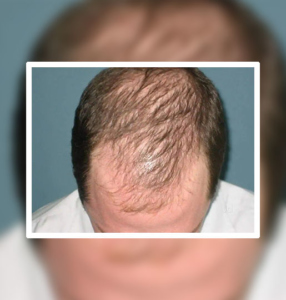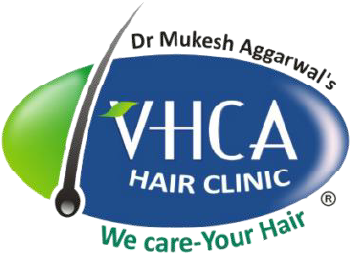Since 1928VHCA Hair Clinic World's 1st Ayurveda Hair Clinic
Baldness
Baldness, also known as alopecia, refers to the partial or complete loss of hair on the scalp or other parts of the body. The most common type of baldness is androgenetic alopecia, which is often referred to as male or female pattern baldness. This condition is primarily hereditary and involves the gradual thinning of hair over time.
Baldness, or alopecia, comes in various forms, each with distinct characteristics. Below are some of the most common types of baldness, including male pattern baldness.

Causes of Baldness
- Genetics:
Family history is a significant factor, especially in androgenetic alopecia.
The exact mechanism is linked to the sensitivity of hair follicles to dihydrotestosterone (DHT), a derivative of testosterone.
Hormonal Changes:
Conditions like pregnancy, childbirth, menopause, and thyroid disorders can trigger hair loss.
Polycystic ovary syndrome (PCOS) is another common cause in women.
Medical Conditions:
Autoimmune diseases, such as lupus and alopecia areata.
Infections like ringworm.
Chronic illnesses like diabetes or anemia.
Medications:
Drugs for cancer, arthritis, depression, heart problems, and high blood pressure can lead to hair loss.
Birth control pills and hormone replacement therapy may also contribute.
Stress and Trauma:
Physical or emotional stress can push hair follicles into the resting phase, causing telogen effluvium.
Traumatic events or surgery can trigger temporary hair loss.
Nutritional Deficiencies:
Lack of essential nutrients such as iron, protein, and vitamins (especially D and B12) can weaken hair and lead to thinning or loss.
Environmental Factors:
Exposure to toxins, pollutants, or harsh chemicals.
Smoking and excessive alcohol consumption.
Symptoms of Baldness
Gradual thinning on top of the head.
Receding hairline, especially in men.
Circular or patchy bald spots.
Sudden loosening of hair, often in handfuls.
Full-body hair loss, typically in cases of alopecia universalis.
Patches of scaling that spread over the scalp, a sign of ringworm.

Diagnosis
Medical History and Physical Examination:
At VHCA Hair Clinic our experts like Dr. Mukesh Aggarwal will inquire about your family history, medical conditions, and hair care routine.
Examination of the scalp and hair.
After all the examination our experts will provide you Ayurveda Medicines of VHCA Hair Clinic.
Pull Test:
Gently pulling a small amount of hair to see how many hairs come out.
Helps determine the stage of hair shedding.
Trichoscopy Test: Trichoscopy is a non-invasive diagnostic technique used to examine the scalp and hair in detail using a dermatoscope or a specialized trichoscope. It allows to our experts to observe the hair shafts, follicles, and scalp skin at a magnified level, helping in the diagnosis of various hair and scalp disorders, including different types of alopecia (baldness).
Lifestyle and Home Remedies:
Healthy Diet: Ensuring a balanced intake of nutrients essential for hair health.
Proper Hair Care: Avoiding harsh treatments and hairstyles that pull on the hair.
Stress Management: Techniques like yoga, meditation, and adequate sleep to reduce stress-related hair loss.
Alternative Therapies:
1.) Ayurveda: Herbal treatments, oils, and massages to promote hair growth and restore balance.
2.) HRP Therapy: Various examinations have demonstrated that the hair repair and protective treatment ( HRP Therapy ) measure is considerably more powerful than other online services that contain medications and various chemicals. HRP treatment helps in fortifying your hair follicles, and accordingly brings about characteristic hair development. With exceptionally qualified specialists by VHCA gives the most secure treatment therapy and is the solitary spot you can trust.
3. Platelet-Rich Plasma (PRP) Therapy: PRP therapy is a popular regenerative treatment for hair loss that uses the patient’s own blood to promote hair growth. The procedure involves drawing a small amount of blood, processing it to concentrate the platelets, and then injecting the platelet-rich plasma into the scalp. The growth factors in PRP stimulate hair follicles, encouraging new growth and strengthening existing hair. PRP is often used to treat androgenetic alopecia (pattern baldness) and other forms of hair thinning. It is a natural, minimally invasive treatment with a good safety profile and requires multiple sessions for optimal results.
4.Growth Factor Concentrate (GFC) Therapy: GFC therapy is an advanced form of PRP that involves concentrating growth factors to an even higher level. By refining the PRP process, GFC therapy delivers a more potent dose of growth factors, leading to potentially faster and more significant hair growth results. This therapy is particularly effective for individuals looking for a more intense hair restoration treatment. GFC therapy also uses the patient’s blood and is minimally invasive, making it a safe option with minimal side effects.
5. Biotin PRP: Biotin PRP, also known as Vitamin B7, is a water-soluble vitamin that plays a crucial role in maintaining healthy hair, skin, and nails. It is commonly used as a dietary supplement to support hair growth and prevent hair thinning. Biotin aids in the production of keratin, the protein that makes up hair, which can help strengthen hair strands and promote growth. While biotin is beneficial for overall hair health, it is often used in conjunction with other treatments like PRP or GFC for more comprehensive hair restoration. Biotin supplements are widely available and are considered safe, though they are most effective when addressing biotin deficiency.
Wigs and Hairpieces:
A non-invasive option to cover bald spots or thinning areas.
Prevention of Baldness
Maintaining a healthy diet rich in vitamins and minerals.
Avoiding excessive use of heat styling tools, chemical treatments, and tight hairstyles.
Regular scalp massages to improve blood circulation.
Managing stress through relaxation techniques.
Seeking early treatment at the first signs of hair loss.
Psychological Impact
Baldness can affect self-esteem and confidence, leading to anxiety and depression in some individuals.
Support groups, counseling, and therapy can help those struggling with the emotional impact of hair loss.
Future Trends and Research
Stem Cell Therapy: Research into using stem cells to regenerate hair follicles.
Gene Therapy: Potential treatments targeting the genes responsible for hair loss.
New Medications: Development of drugs that can more effectively inhibit hair loss or promote hair growth without significant side effects.
3D Printing: Innovative approaches to hair transplantation and hairpiece creation.
Baldness is a complex condition with various causes and manifestations, but advancements in medical and alternative treatments offer hope for those seeking to manage or reverse hair loss. Early diagnosis and treatment, along with a holistic approach to health and wellness, can significantly improve outcomes for individuals facing baldness.
Connect for wellness: Begin Your Journey Today
